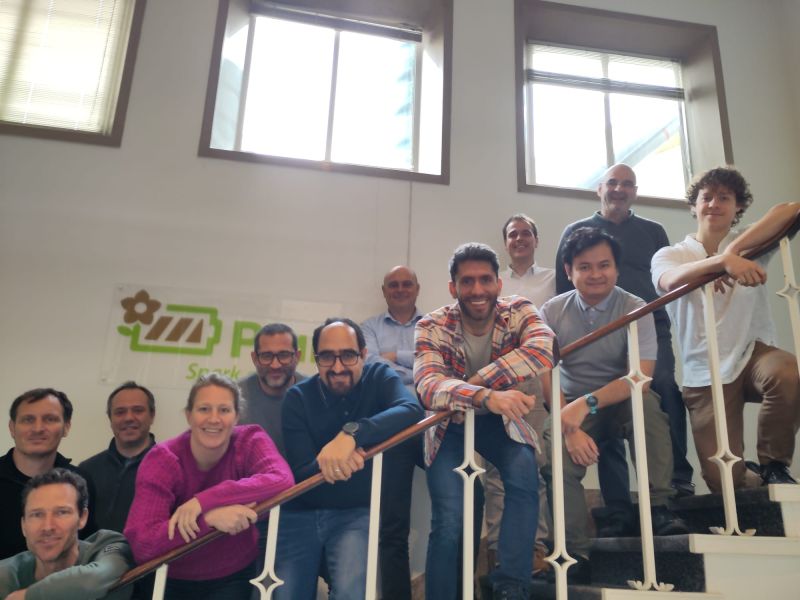The EcoSentinel Project revolutionizes large-scale soil and wilderness monitoring with plant-based technology
written by Alan Briones Delgado, Joan Navarro Martin
The ability to monitor soil and natural ecosystems is fundamental to promoting environmental sustainability, preserving biodiversity, and enhancing climate resilience. However, current soil monitoring approaches face challenges in terms of power supply, data transmission, sensor durability, scalability, and integration with natural systems. The EcoSentinel project proposes a novel Techno-Natural Internet of Things (IoT) approach for large-scale, sustainable remote monitoring of soil and wilderness, leveraging the biological processes and resilience of plants.
Smart plants as sensing and communication nodes in soil monitoring systems
The EcoSentinel project aims to transform plant communities into active participants in a self-sustaining wireless communication system.
This innovative system leverages the biological functions and resilience of plants transforming them into selfpowered digital nodes within an IoT domain. By integrating plant microbial energy harvesting with electromagnetic signal transmission through plant structures, EcoSentinel aims to create a carbon-negative, bio-integrated IoT system capable of autonomously monitoring environmental changes. This cybernetic plant interaction paradigm represents a significant shift in IoT-driven environmental sensing, eliminating the need for external power sources and minimizing human intervention while ensuring continuous data collection.
Therefore, the digital system seamlessly integrates with the natural domain, allowing plants to autonomously sense environmental parameters, share data, and maintain connectivity within a large bio-digital network.
In addition to their biological function, thanks to the integration with IoT technologies, plants play a fundamental role in the creation of increasingly efficient monitoring systems.
- Plants as Antennas: Utilizing plants’ natural communication networks and bioelectrical properties to transmit electromagnetic signals.
- Plants as Energy Sources: Harnessing the symbiotic relationship between plants and soil microorganisms to generate renewable bioelectricity.
- Plants as Sustainable Wireless Communication Systems: Integrating short-range and long-range connectivity through a System-on-Chip solution optimized for power transfer from plant microbial fuel cells to plant-based antennas.
- Plants as Living Biosensors: Exploiting plants’ responses to environmental fluctuations to extract real-time insights about plant health and surrounding environmental conditions.

EcoSentinel’s plant to plant communication.
Plants are used for energy harvesting, such energy is used to power a microcontroller that senses environmental parameters, it is attached to a transceiver that uses plants’ leafs as antennas to communicate and broadcast the sensed data
Precision agriculture and sustainable farming
Soil quality is a key determinant of agricultural productivity, influencing crop growth, nutrient availability, and water retention. Conventional soil monitoring involves periodic sampling and analysis, which can be time-consuming and resource-intensive. Interestingly, precision agriculture utilizes data-driven techniques to optimize farming operations, improve crop yields, and reduce environmental impact. However, this usually requires significant infrastructure and energy resources. So far, traditional (IoT) wireless sensor networks have provided an appealing approach to address these needs, but their reliance on external batteries, the required expert knowledge for their operation and maintenance, limits their broad adoption. The proposed plant-integrated IoT sensing system featured by EcoSentinel, could offer a sustainable alternative to conventional sensor networks used for agriculture, reducing reliance on external power sources while enhancing precision farming techniques.
By enabling direct and real-time communication between plants and digital systems, this technology could help farmers make more accurate decisions about irrigation, fertilization, and pest control, leading to increased efficiency and optimization of water resources. Specifically, by measuring variations in electrical conductivity, moisture levels, and nutrient composition, plant-based biosensors can provide farmers with real-time data on soil health, allowing for precision irrigation, fertilization, and soil management. Also, it is well known that excessive use of fertilizers contributes to soil degradation, water contamination, and greenhouse gas emissions. By monitoring plant bioelectrical activity, soil pH levels, and microbial interactions, the system can intrinsically detect nutrient deficiencies and imbalances in real time before they are even visible.

Plant microbial fuel cell
The black dots represent the organics (rhizodeposition) deposited by plant roots in the soil, which form the food for the (electrochemically active) microbes, which are the “green worms” on our tubular electrode (in green).
The microbial fuel cell, which is basically the tube in the schematic, including the microbial biofilm on the outside, works by converting the organics from the plant to electrons and protons (plus HCO3−) at the outside (anode) electrode. At the inside electrode (the cathode) the electrons that come back from the electric application (powered by the plant microbial fuel cell), are combined with the protons that flow from anode to cathode inside the cell and oxygen supplied (passively) by the aeration tube in the schematic, to form water.
The electricity generation is basically driven by the RedOx conditions in the soil/cell; oxidation of organics under anaerobic conditions and reduction of oxygen to water under aerobic conditions, which make a electric potential difference between the outer electrode of the tube (anode) and the inner electrode (cathode).
Beyond the agriculture industry
EcoSentinel’s potential extends beyond environmental monitoring and sustainable agriculture, offering transformative solutions for various industrial sectors.
In the energy sector, EcoSentinel can optimize the management of bioenergy crops by providing real-time data on plant health, growth rates, and biomass production. This can lead to increased efficiency in biofuel production and a more sustainable approach to renewable energy.
For the construction industry, EcoSentinel can be integrated into green building initiatives, monitoring the health and performance of green roofs, vertical gardens, and urban green spaces. This can contribute to creating more sustainable and energy-efficient buildings.
In the pharmaceutical industry, EcoSentinel can be used to monitor the growth and health of medicinal plants, ensuring optimal conditions for the production of plant-derived drugs. This can lead to a more sustainable and efficient production of pharmaceuticals.

Plant as living biosensor
Each plant senses in-field data related to itself and its environment as well as receives data tele-generated by neighboring plants. Data are broadcast to surrounding plants that behave in the same way. Furthermore, EcoSentinel’s ability to monitor environmental conditions can be valuable for industries that rely on natural resources, such as forestry, fishing, and mining. By providing real-time data on environmental changes, EcoSentinel can help these industries operate more sustainably and minimize their environmental impact. The integration of EcoSentinel’s plant-based sensing and communication system into various industrial sectors can lead to increased efficiency, sustainability, and a more harmonious relationship between industry and the environment.
Furthermore, EcoSentinel’s ability to monitor environmental conditions can be valuable for industries that rely on natural resources, such as forestry, fishing, and mining. By providing real-time data on environmental changes, EcoSentinel can help these industries operate more sustainably and minimize their environmental impact.
The integration of EcoSentinel’s plant-based sensing and communication system into various industrial sectors can lead to increased efficiency, sustainability, and a more harmonious relationship between industry and the environment.
The path towards new plant-based monitoring system
The EcoSentinel project, funded within the Horizon Europe Framework with about 3 Million Euros contribution, is led by Ramon Llull University of Barcelona. The project consortium includes also University of Genova (Italy), University of Trento (Italy), University of Cote D’Azur (France), Ignion S.L. (Spain) and Plant-E B.V. (Nederlands). The project started in December 2024 and will end in December 2027.
The project is divided into the following work packages and the resource allocation:

The first step focuses on Theoretical Foundations on Plants Digitalisation, involves defining research
requirements, studying theoretical foundations, and designing elements for the Eco-Sentinel Proof of Concept (PoC). This connects the second phase, Experiments on Plants Digitalisation, where experiments are conducted and results extracted. These results inform the EcoSentinel Proof-of-Concept, which co-designs the PoC, plans tests, and validates the EcoSentinel.
EcoSentinel not only aims to redefine plant-environment interaction but also paves the way for a carbon-negative communication system, merging biological intelligence with IoT capabilities. Through the seamless blending of plant microbial fuel cells energy harvesting, electromagnetic (EM) signal transmission through plants leaves, and adaptive communication protocols, EcoSentinel sets the foundation for a scalable, self-sustained, and nature-integrated IoT sensing architecture. This novel approach is committed to enable continuous ecosystem monitoring, offering a sustainable and resilient alternative to conventional IoT-driven electronic sensor networks that often struggle with energy limitations, environmental impact, and scalability.









